National Sea Rescue Institute
This article needs additional citations for verification. (January 2009) |
 | |
| Abbreviation | NSRI |
|---|---|
| Formation | 1967[1] |
| Type | Non-profit organization |
| Purpose | Search and rescue |
| Headquarters | 1 Glengariff road, Three Anchor Bay, Cape Town |
| Location |
|
Region served | Southern Africa |
Budget | Donations, bequests and sponsorships cover the annual running costs. Use of volunteers avoids a salary bill around R0.5m per annum. |
| Website | https://www.nsri.org.za/ |
The National Sea Rescue Institute (NSRI) is a voluntary non-profit organization in South Africa tasked with saving lives through drowning prevention. It operates 41 bases (as of 2020) comprising coastal stations and inland stations on dams. There are crews on standby at all hours. There are over 1000 volunteers equipped with sponsored rescue craft, rescue vehicles, quad bikes and tractors, supported by an operations department at the head office.
The NSRI works closely with other Search and Rescue organisations[example needed] in South Africa.
History[]
Following an incident at Stilbaai near Mossel Bay on the south coast of South Africa in 1966, in which 17 fishermen drowned after three fishing boats sank in a storm, Miss Pattie Price of Simon’s Town whose own life had been saved by a RNLI lifeboat in the English Channel, wrote a series of letters to the newspapers to advocate for the formation of a sea rescue organisation in South Africa.
Captain Bob Deacon and Ray Lant were the first volunteers to respond to this call and in 1967 the South African Inshore Rescue Service (SAISRS) was started, with a 4.7m inflatable boat donated by the . The SAISRS was later renamed to National Sea Rescue Institute (NSRI) and continues the tradition of operation by volunteers.[2]
List of NSRI stations[]



- Agulhas - Station 30, -34.798567, 20.059433[3]
- Bakoven - Station 2, -33.960583, 18.373033 (Cape Town)[3]
- Ballito - Station 41, -29.437578, 31.222571[3]
- Durban - Station 5, -29.873933, 31.050767[3]
- East London - Station 7, -33.02305, 27.8913[3]
- Gauteng - Station 27, -26.270759, 28.112268 (inland)[3]
- Gordon's Bay - Station 9, -34.16435, 18.859733 (Cape Town)[3]
- Hartebeespoort Dam - Station 25, -25.730167, 27.86045 (inland)[3]
- Hermanus - Station 17, -34.433417, 19.22515[3]
- Hout Bay - Station 8, -34.05025, 18.345333 (Cape Town)[3]
- Jeffrey's Bay - Station 37, -34.048333, 24.923333[3]
- Kleinmond - Station 42, -34.335399, 19.012628[3]
- Knysna - Station 12, -34.076083, 23.060383[3]
- Kommetjie - Station 26, -34.140833, 18.328833 (Cape Town)[3]
- Lambert's Bay - Starion 34, -32.090726, 18.300401[3]
- Melkbosstrand - Station 18, -33.729, 18.4385 (Cape Town)[3]
- Mossel Bay - Station 15, -34.180583, 22.1488[3]
- Mykonos - Station 4, -33.047367, 18.0398[3]
- Oyster Bay - Station 36, -34.169673, 24.653434[3]
- Plettenberg Bay - Station 40, -34.058333, 23.378[3]
- Port Alfred - Station 11, -33.594933, 26.89095[3]
- Port Edward - Station 32, -31.048217, 30.231167[3]
- Port Elizabeth - Station 6, -33.967617, 25.633567[3]
- Port Nolloth - Station 43, -29.238409, 16.928872[3]
- Port St Johns - Station 28, -31.530022, 29.4643592[3]
- Richards Bay - Station 19, -28.791633, 32.08365[3]
- Rocky Bay - Station 39, -30.334283, 30.733833[3]
- Shelly Beach - Station 20, -30.808517, 30.412217[3]
- Simon's Town - Station 10, -34.192283, 18.434367 (Cape Town)[3]
- St Francis Bay - Station 21, -34.184333, 24.8523[3]
- St Lucia - Station 40, -28.372602, 32.414163[3]
- Still Bay - Station 21, -34.385733, 21.423917[3]
- Strandfontein - Station 16, -34.077876, 18.573032 (Cape Town)[3]
- Table Bay - Station 3, -33.909167, 18.423617 (Cape Town)[3]
- Theewaterskloof - Station 38, -34.176, 19.262533 (inland)[3]
- Vaal Dam - Station 22, -26.895867, 28.113433 (inland)[3]
- Wilderness - Station 23, -33.9952, 22.580567[3]
- Witbank Dam - Station 35, -25.9093, 29.308733 (inland)[3]
- Witsand - Station 33, -34.391333, 20.837833[3]
- Yzerfontein - Station 34, -33.346, 18.149833[3]
This section needs expansion. You can help by . (December 2020) |
Rescue craft[]
The NSRI has used a wide range of rescue vessels and types of rescue vessel over the years.
- RL 36, 9m deep V, Cold moulded wood:
- Pearl van Riet, Station 9
- Brede class: (RNLI design)
- Spirit of Safmarine. Station 10,
This section needs expansion with: describe the history of the vessel types in use and the characteristics of each type. You can help by . (January 2021) |
Offshore Rescue Craft class[]

The first vessel of the offshore rescue craft (ORC) class vessel was procured from a French boatyard in 2019 and stationed at Durban. The vessel has a 14.8m long composite hull with a 4.8 m beam, and is suitable for search and rescue operations up to 50 nautical miles offshore.[4] The second vessel of the class was finished from an imported set of mouldings and delivered to Station 10 (Simon's Town) from Two Oceans Marine in Cape Town in April 2021. It will be kept ready to launch at a few minutes notice on a cradle in the boathouse.
The rest of the series will be manufactured in Cape Town under license using moulds taken off the second boat's mouldings. The vessel is longitudinally subdivided into forepeak, forward accommodation for survivors, tank space with heads, engine room and steering flat. The superstructure is on the main deck and comprises a watertight wheelhouse, which provides a high centre of buoyancy for self-righting, and has a raised exterior steering position on the port side. The transom has a ladder for boarding from the water and two small platforms just above the waterline. There is a substantial towing bollard on the quarterdeck and a gap in the stern rail at the top of the ladder which also serves as a fairlead for towing lines. The crew seating includes safety belts and shock absorber mountings to mitigate vertical acceleration shock loads.
A track with sliding cars runs around the wheelhouse just below the handrail, providing secure but mobile harness clip-off points for crew working on or traversing the side decks. The handrails on the foredeck and side decks are inset to avoid damage when alongside large vessels in a seaway. There is a small but sturdy davit on the port side suitable for hoisting survivors on board, in clear view of the exterior control point.
Structure is fibre reinforced plastic composite, partly foam cored and partly solid skin with foam cored frames. Structural glass fibres are used for most of the layup, with carbon fibre stiffening where most effective. High density core material is used in heavily loaded components such as engine beds.
Specifications[]
Specifications:[4]
- Designation ORC 140.RS
- Survivor capacity: 23/24 persons.(sources vary)
- Crew 6[clarification needed]
- Expected lifespan: 40 years.
- Self righting by inherent stability when intact
- Original vessel manufacture: France
- Series manufacturer: Two Oceans Marine (Cape Town)
- Cost per vessel: R20 million
- Series cost: R180 million
- Maximum speed of about 28 knots with crew, equipment and full tanks
- Range of 250 nautical miles at 20 knots cruising speed with 25% reserve.
- Length overall 14.8 m
- Moulded length 13.85 m
- Waterline length 13.56 m
- Beam overall 4.8 m
- Beam moulded 4.6 m
- Depth 2.08 m
- Draught (loaded) 1.4 m
- Displacement (light) 15 900kg according to the stability book
- Displacement (loaded)
- Fuel capacity 2 tanks of 1000 litres each
- Engines: 2 x Cummins QSC 8.3M marine diesels producing 441 kW at ????rpm
- Gearboxes: ZF 370 V, a 10° V-drive, remote mount marine transmission.[5]
- Propellers, rudders and shafts CJR[clarification needed]
- Towing bollard rated for 4.5 tonne
- Vessel sound level 76 dB[clarification needed]
Names and stations:
- 14-01, Station 5, Durban
- 14-02, "Donna Nicholas", Station 10, Simon's Town, April 2021
- 14-03,
Gallery[]
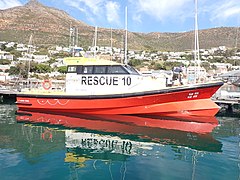
Profile from port

Bow

Stern
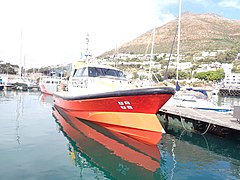
Port bow
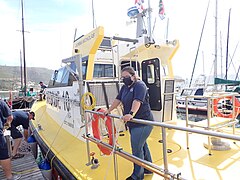
View from port quarter
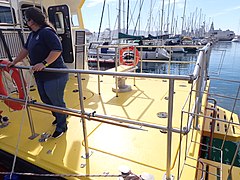
Quarterdeck railings

Towing gear
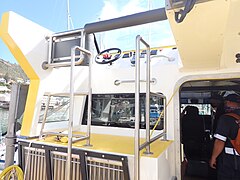
Flying bridge

Superstructure from aft

View forward from flying bridge
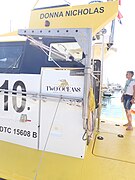
Davit

Engine room soft patch
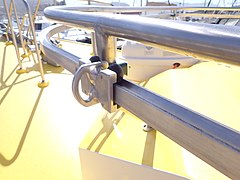
Handrail and jackstay track with car

Anchor gear and pulpit rail

Liferaft and forward escape hatch

Engine freshwater flush connection
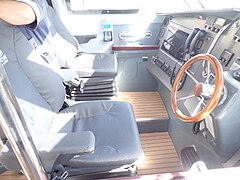
Helmsman's seat

Navigation table
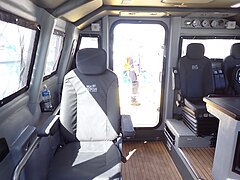
Wheelhouse exterior watertight door
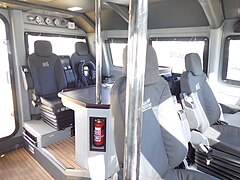
Port side seating

Crew seat detail
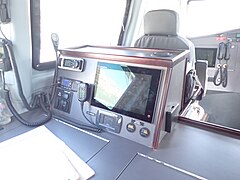
Navigators instrument panel

Forepeak and anchor locker access
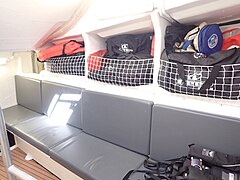
Survivor seating port side

Galley area and companionway ladder starboard forward
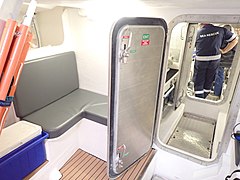
Seating and watertight door starboard aft

Companionway ladder and doorway starboard

Deckhead escape hatch with drop-down ladder looking aft
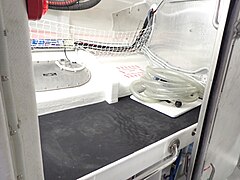
Starboard tank space
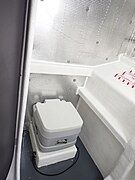
Heads in port tank space
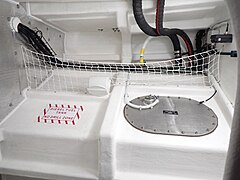
Port tank space
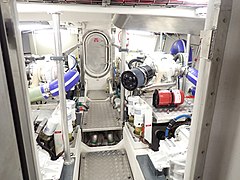
View from forward watertight door

Starboard engine and gearbox

Port engine and gearbox
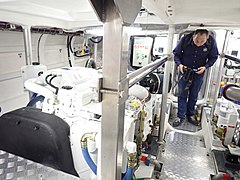
Port engine aft

Starboard exhaust

Port steering ram, tiller, rudder stock and link bar
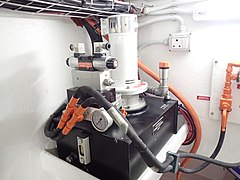
Electro-hydraulic steering motor
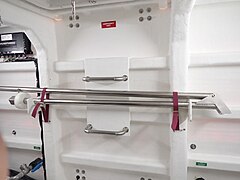
Emergency tiller stowed against transom, emergency exit above
See also[]
Similar organizations around the world
- Royal Netherlands Sea Rescue Institution
- Royal National Lifeboat Institution (Ireland and the United Kingdom)
- Société Nationale de Sauvetage en Mer (France)
- German Maritime Search and Rescue Service (Germany)
- Norsk Selskab til Skibbrudnes Redning (Norway, also called Redningsselskapet)
References[]
- ^ "Our History". NSRI. Retrieved 2009-01-18.
- ^ "History". www.nsri.org.za. Retrieved 11 January 2021.
- ^ a b c d e f g h i j k l m n o p q r s t u v w x y z aa ab ac ad ae af ag ah ai aj ak al am an "Rescue base finder". www.nsri.org.za. Retrieved 3 December 2020.
- ^ a b "NSRI's ORC project is taking shape". Sea Rescue. Cape Town, South Africa: National Sea Rescue Institute. Summer 2020. pp. 28 to 29.
- ^ "Marine Propulsion Systems ZF 370 V" (PDF). www.performancediesel.com. Retrieved 25 April 2021.
External links[]
- Commons:Category:NSRI 14m offshore class rescue craft
- NSRI homepage
- The ASR, one of the 3 helicopter units of the NSRI
- NSRI Station 2 at Bakoven
- NSRI Station 8 at Hout Bay
- NSRI Station 10 Simon's Town
- NSRI Station 12 at Knysna
- NSRI Station 14 at Plettenberg Bay
- NSRI Station 15 at Mossel Bay
- NSRI Station 19 at Richards Bay
- NSRI Station 18 at Melkbosstrand
- South African Search and Rescue Organisation
- Sea rescue organizations
- Emergency medical services in South Africa
- Maritime history of South Africa






































